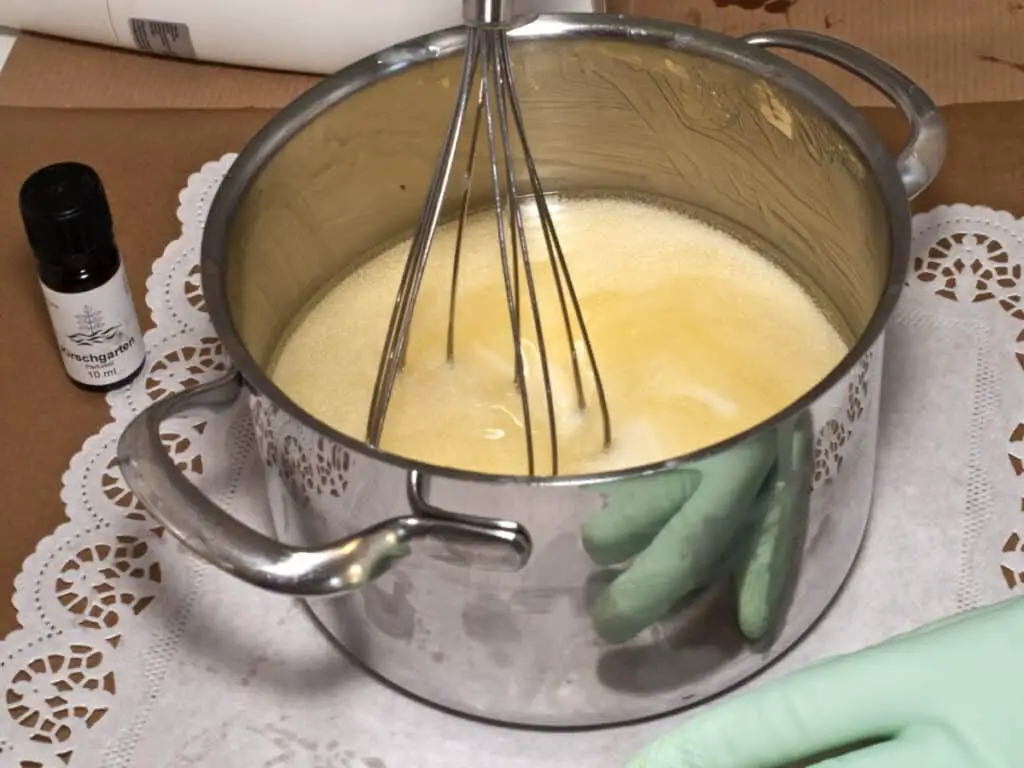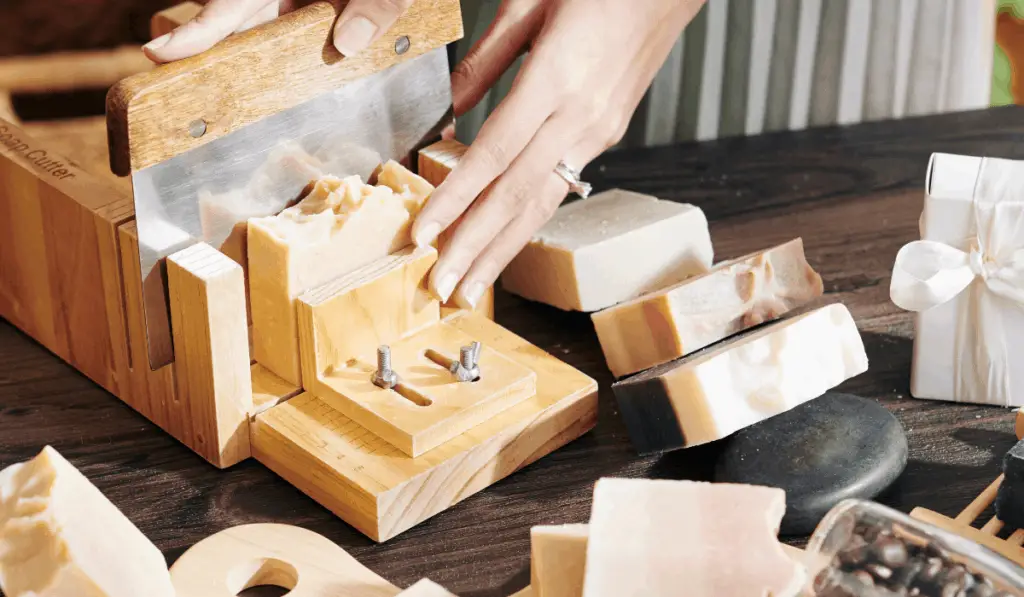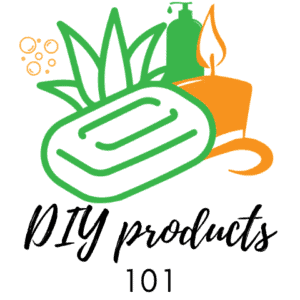Knowing the real cost before starting a business or hobby is can determine which path you may take in your career. But finding the right information can be very difficult at times. So today, I will discuss all the details you need before starting your soap-making business.
A cost of around $615.37 is expected if you wish to start making your soap. This includes the overhead costs at $240—the cost of ingredients at $105.75 and, lastly, the equipment at $269.62. Costs can be lowered considerably by buying your ingredients in bulk and starting in your own house/garage.
Whether you’re seeking a fun hobby, saving money, or pursuing a new business venture, our step-by-step guide makes crafting spa products enjoyable and easy, perfect for hobbies, saving money, or starting a business. Explore 126+ recipes, from soaps to lotions, with our beginner-friendly Quick Start Guide. Ditch store-bought products with unknown chemicals and embrace personalized, high-quality creations that cater to allergies and sensitivities using The Handcrafter’s Companion.
Before we start I would like to remind you that it’s only meant to give you an idea. As with any business or hobby, it all depends on what you want to make and what materials you wish to use.
What I mean by this is, will you be making soap as a business, or is it just as a hobby? If it is a business, would you be making it at home or rent a working place? Do you want to go all out and buy all you need as a business right from the get-go or just want to start and see how it goes with a basic setup?
Does the recipe you wish to use have many expensive ingredients, or is it pretty basic? So, as you can see, it is nearly impossible to give you the exact cost. But, we can have an estimate, an idea for a specific scenario, and from there, it should be easy to determine where yours will be.
We will go through most scenarios so no worries, by the end of this article you are one step closer to start your business. However, if you wish to know how much it costs as a hobby, you can find all the info in this article.
First, your overhead cost
Similar to any business, before starting, you need to make a business plan, and within this plan, you need to calculate all of your costs. So, what are overhead costs? These are things like rent, electricity, insurance, etc. These fixed costs can vary from one to another.
If you are planning on starting off making your soaps in your garage or home, you won’t have any extra rent to pay. I would personally 100% recommend starting at home at a small scale and work your way up, but this guide will be about how much costs you might have if you rent a workplace and pay these additional costs on a monthly basis.
Before we continue, it is inevitable that your costs will be different in comparison to others. I can only give you a general idea, but with this, you might be able to make your own calculations.
Depending on the state you live, fixed costs such as rent can vary, you might be able to rent a room for $150 while someone else in another state needs to pay $300. Following electricity, internet, and heat or things like marketing costs are also things that may vary, but there is an average for all of them in most cases.
Rent: $150
As previously mentioned, the price may vary, but when choosing a room or place to start your business, you should also think about a spot to cure your soap. This means you should try to find a cool, dry, and well-ventilated place, also a place that has enough room to place your racks (bakers racks is a good option).
Electricity – Heat – Water: $60
You can save on electricity unless you are using an electric stove, you can even use a camp stove to get things going. You might need power if you use a crockpot, but that’s about it. The costs are different for each state; you can find the price per kWh for electricity in this link. But we will go with an average of $60 since we will also include heating and water within this cost.
Insurance: $30
Insurance is a necessity, just like with any business, you need to get this done before you start manufacturing. There are many types of insurances out there, some of them are catered to your needs, and others are more general, here is a short-list.
- Handcrafted Soapmaker’s Guild: Another group policy that might be interesting is the HMSG insurance. They also offer insurance specially made for soap makers. However, with this one, you need to be a member to be eligible. You have two options between $265 and $375. Of course, the lower is for lower coverage. You can find all the info you need on their website
- HandMade Artisans Insurance: If you prefer something general, The Handmade Artisans Insurance may be the ideal coverage for you. Within this insurance, you also have the product liability coverage, which the one you need as an artisan. The annual fee is at $275, which is very low if you ask me, and probably the best option out there to start with.
- RLI: The pricing may vary depending on how much you are earning and selling, but RLI also has a homecrafters business insurance. They can cover up to $7500 in retail sales.
- Homeowners insurance: In case you are operating from your house and not renting a workplace, homeowners’ insurance might be the solution for you, some of them might cover you up to $5000 in sales.
- Indie Business Network: If you prefer group policies, IBN might be your best pick. They have one policy specially made for the handcraft soap industry. It costs around $400 per year, and you are covered for $1,000,000 in aggregate insurance for product liability.
This is more or less what your monthly costs would look like. You can add some other miscellaneous costs, such as phone costs, but to be honest with you, I do not think that is something you will have at the very beginning.
Marketing is another one unless you are planning to do paid marketing; this can be old calls/emails; you should not have any at the very beginning. That is if you do your own, such as using social media (for example, Facebook groups, Pinterest, Instagram, etc.).
| Rent | $150 |
| Insurance | $30 |
| Electricity – Water- Heat | $60 |
| Total: | $240 |
Materials (direct) costs

First, we need to discuss the costs of the materials you need to make your soap. You’ll only need to buy them once, so these are separated costs and should not be calculated together with the ingredients you need to make your soap batch. These are:
- Safety gloves
- Safety goggles
- Stick Blender
- Easy Pour Containers
- Melting pot
- Infrared Thermometer
- Silicone spatulas
- Molds
| Safety Gloves | |
| Safety Goggles | |
| Stick Blender | |
| Melting Pot | |
| Infrared thermometer | |
| Silicone Spatulas | |
| Easy Pour Container | |
| Molds | |
| Total: | $269.62 |
Now let’s focus on raw materials, this is probably the trickiest part of the whole soap-making cost business since all recipes are different, and therefore, costs vary significantly from recipe to another. In this example, we will take a basic recipe and calculate using a 5-pound mold. And then we will calculate the number (and amount) of ingredients we need.
| Coconut Oil | 17.33 oz. |
| Olive Oil | 17.33 oz. |
| Palm Oil | 17.33 oz. |
| Sodium Hydroxide Lye | 7.51 oz. |
| Distilled Water | 17.16 oz. |
| Lemon Fragrance Oil | 2.5 oz. |
| Color (mica) u wish to add | 0.1 oz. |
Now that we have nailed down the measurements, it gets much easier to calculate the rest. We can now calculate the costs for one batch, and from there, change it for each recipe.
But, as you may already have guessed, you don’t buy your ingredients in such low quantities, but you buy by the bottle or pounds. So, this means you’d need to calculate by the volume you buy them.
This also means you can buy one bottle of each or buy in wholesale to buy cheaper. But, I would only advise doing this if you know you need that many.
Talking about buying wholesale, this is the only way to push costs down, this is also how big manufacturers are doing it, so you should too! Sometimes, an item is sold in small or medium or large quantities, and each has different prices.
If the option to buy in larger quantities is possible and there is a significant difference in price per pound/ounce, you should definitely go for it. Basically, this means you need to calculate per/ounce to have a good overview of your costs. Let’s just say that 1 pound of palm oil goes for $4 per pound; this means it costs you 0.25 per ounce.
Now you know this, you need to calculate for 30 pounds of palm oil. If 30 pounds of palm oil costs $100, this means it only costs you 0.21 per ounce. To be able to calculate this way, you need to know how much you need per batch of soap.
At the very beginning, when you just start out, I would not really advise buying wholesale, because you won’t be able to sell that much anyway. Unless you have clients lined up already for that many, start buying in smaller quantities that’s quite alright! Focus on quality instead of quality, focus on just making your clients happy.
Now let’s calculate the difference between the two, shall we?
I have highlighted bulk prices in green so it would be easier to read.
| Ingredient | Normal price / Bulk price | Price per oz. / Bulk per oz | Usage per batch | Cost per batch | Bulk cost per batch |
| Coconut Oil | $19.90 (7lbs) $68.90(35 lbs) | $0.17 / Fl Oz $.123 / Fl Oz | 17.33 oz. | $3.99 | $2.13 |
| Olive Oil | $32.95 (7lbs) $105.95(35 lbs) | $.294 / Fl Oz $.189 / Fl Oz | 17.33 oz. | $5,09 | $3.27 |
| Palm Oil | $15.95 (7lbs) $56.95(35 lbs) | $.142/ Fl Oz $0.10 / Fl Oz | 17.33 oz. | $2,46 | $1.73 |
| Sodium Hydroxide Lye | $10 | $0.37 / Fl Oz | 7.51 oz. | $2.78 | $2.78 |
| Distilled Water | $1 | $.0078 | 17.16 oz. | $0.13 | $0.13 |
| Lemon Fragrance Oil | $23.95 (16 oz.) $115.95 (5 lbs) | $1,49 / Fl Oz $1.145 / Fl Oz | 2.5 oz. | $3.74 | $2.86 |
| Color (mica) u wish to add | $2 (1 oz.) $28 (16 oz.) | $2 / Fl Oz $1.75 / Fl Oz | 0.1 oz. | $0.2 | $.175 |
| Total cost | $105.75 $386.75 | Cost per batch: | $18.39 | $13.07 | |
| Cost per bar: | $0.92 | $0.65 |
So based on the calculation above, it costs you 0.92 to make one bar of soap if you were to buy in smaller quantities. But as you can see, the bulk price is significantly lower at $0.65 per bar of soap. Clearly, you’d want to have cheaper costs, but you should be careful with buying too much and finally ending up with too much soap in your hands and no costumers to sell.
Buying in bulk and producing this much of soap is probably the way to go if you want to make better profits. However, you need to make sure they also sell at the same rate. This means, if you are buying in bulk like shown above, you’ll be making 640 bars of soap.
That is a lot of soap if you ask me. Unless you are sure you can sell all of them, I would not suggest buying in bulk. Why might you ask? Shelf-life…Fixed oils have shelf-life and therefore, will go bad after some time.
This is why buying in larger quantities is not such a good idea when you just start with your business. The best thing in my personal opinion you can do is, start with small amounts and the moment you see a significant increase in sales switch over to wholesale.
Labor costs

Aah labor costs, the one cost that many tend to forget. Understandable, if you ask me, most soap makers start their business as a side business. And usually, they do this in their free time. So labor cost would not be even considered.
Probably the most difficult question is, how much are you supposed to pay yourself? What is your time worth? Or should you just pick the average salary of a soap maker? According to Simply Hired, the average hourly rate of a soap maker should be around $16.40. Does this mean you must calculate the same? No, of course not. But, the higher the hourly wage, the higher the cost of the soap will be.
And if you are new, you can’t really be that expensive, can you? I am not saying you should start low, but a little cheaper can help you tremendously in the beginning. So if you start this as a side job, you can afford to be a little less expensive.
The average time to make one batch of soap varies from one person to another. In the beginning, when you are still new to the process, it might take you a little longer, but the further you go, the better you’ll get. So, eventually, you’ll be able to make one batch of soap under one hour. So this means you’ll have 20 bars of soap per hour.
And if we would take the average hourly rate at 16.40, the labor costs per bar should be 0.82. Do keep in mind, that this is only for the labor time when making soap, you can also calculate the time you spend on your website (if you have one) or emails and phone calls, etc.
So now, we have a clear view of our cost; we can start adding them up and looking at different scenarios. But, before we dive in, the one time cost of the materials you need will not be calculated in this equation.
So let’s assume you are starting at home, so this means you will not pay extra electricity – water – heat nor will you pay for rent. This means that you only have the direct material cost of your soap and the labor costs. But, we have to keep in mind we have the difference between bulk pricing and non-bulk pricing. So let’s see how this looks like, shall we?
The first scenario is, making your soap at home without having any indirect costs and Non-Bulk pricing.
| Total costs per bar of soap in Non-bulk pricing | |
| Direct Material costs: $0.92 | |
| Labor costs: $0.82 | |
| Total: $1.74 |
In the next scenario we will do the same but with bulk pricing.
| Total costs per bar of soap in Bulk pricing | |
| Direct Material costs: $0.65 | |
| Labor costs: $0.82 | |
| Total: $1.47 |
In the next scenario, we will be calculating also add indirect costs and go with the non-bulk pricing. Since we can only make 120 soap bars in the none bulk pricing, you can only sell that many. So, if the indirect costs for the month were $240, as calculated earlier. And you were able to sell all 120 bars; the indirect costs would add $2 to each bar.
| Total costs per bar of soap in Non-bulk pricing | |
| Direct Material costs: $0.92 | |
| Indirect costs: $2 | |
| Labor costs: $0.82 | |
| Total: $3.74 |
Let’s see how this looks like if you were to go for bulk pricing and also have indirect costs. But in this scenario, you’ll be selling all of your 640 bars you were able to make with the materials you have.
| Total costs per bar of soap in bulk pricing | |
| Direct Material costs: $0.65 | |
| Indirect costs: $0.37 | |
| Labor costs: $0.82 | |
| Total: $1.84 |
There is also a scenario where you’re only using half of your ingredients because you only want to produce that much. In that scenario, you need to divide the amount of soap by your indirect costs.
As an example, we will take the none-bulk pricing, and only half of the ingredients per month will be made. So this means you have indirect costs at $240, which stays the same and then only half of the ingredients used, which is at 60 soap bars. This means that your indirect costs will come to $0.25.
Shipping costs

Shipping costs vary greatly depending on where you order your supply from. So this is something you can add to your equation. A simple way to do this is by adding this as a direct cost. If it costs you $20 to get your ingredients shipped to you, you simply add this as a direct cost.
So let’s take the total cost for non-bulk pricing, which was $105.75 you add the $20 to that and will have a final total price of $125.75. The one thing you need to remember is, always try to make sure you try to order all of your ingredients in one shipment, this way you will lower the costs even further.
When it comes to shipping costs to send your soap to your customer, you need to calculate this for each customer separately. This means that if your customer wants to order just one soap bar from you, you need to make sure that your customer understands that there is an additional shipping cost they need to pay.
Packaging costs
Packaging costs are also another thing that varies greatly. Depending on how you want to package your homemade soap and what type of decoration you wish to use, it will also affect the packaging’s pricing.
Let’s just say you wish to use a ribbon $0.02 and label $0.08 and shrinkwrap $0.15 to package your soap. This means that you have a total of $0.25 cost to package each soap bar.
The total start-up costs

Probably one of the most asked questions out there is the total start-up costs for soap making business.
Earlier we mentioned we had a one time cost, that came to a $269.62. In addition, you’d want to add the initial costs for your non-bulk pricing ingredients. So, if we would put this in a perspective, we would get the following.
| One time costs | $269.62 |
| Ingredients cost (non-bulk pricing) | $105.75 |
| Indirect costs (in case you have one) | $240 |
| Total: | $615.37 |
So this means, to start off, you only need $615.37, if you were to add packaging to this and other variables such as shipping costs you might end up with $700 to start.
I think that starting a soap making business is one of the cheapest businesses one could do. It doesn’t take that much to start and if in case you are not successful you are not losing thousands of dollars. You may sell to friends and family if you want to stop. Another option is to wrap them as gifts, homemade soaps are the perfect gifts!
